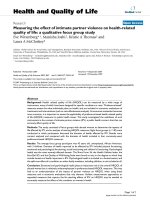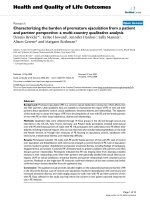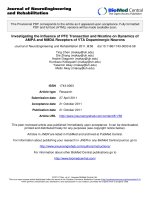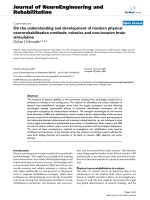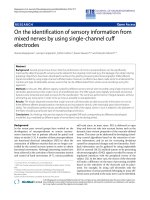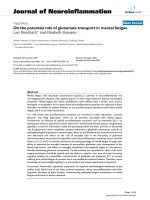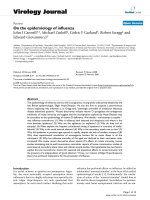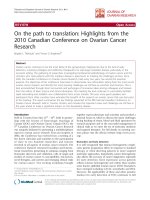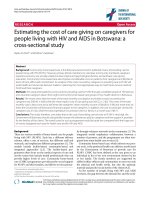báo cáo hóa học: "On the identification of sensory information from mixed nerves by using single-channel cuff electrodes" pot
Bạn đang xem bản rút gọn của tài liệu. Xem và tải ngay bản đầy đủ của tài liệu tại đây (995.73 KB, 15 trang )
JNER
JOURNAL OF NEUROENGINEERING
AND REHABILITATION
Raspopovic et al. Journal of NeuroEngineering and Rehabilitation 2010, 7:17
/>Open Access
RESEARCH
BioMed Central
© 2010 Raspopovic et al; licensee BioMed Central Ltd. This is an Open Access article distributed under the terms of the Creative Com-
mons Attribution License ( which permits unrestricted use, distribution, and reproduc-
tion in any medium, provided the original work is properly cited.
Research
On the identification of sensory information from
mixed nerves by using single-channel cuff
electrodes
Stanisa Raspopovic
1
, Jacopo Carpaneto
1
, Esther Udina
2,3
, Xavier Navarro*
2,3
and Silvestro Micera*
1,4
Abstract
Background: Several groups have shown that the performance of motor neuroprostheses can be significantly
improved by detecting specific sensory events related to the ongoing motor task (e.g., the slippage of an object during
grasping). Algorithms have been developed to achieve this goal by processing electroneurographic (ENG) afferent
signals recorded by using single-channel cuff electrodes. However, no efforts have been made so far to understand the
number and type of detectable sensory events that can be differentiated from whole nerve recordings using this
approach.
Methods: To this aim, ENG afferent signals, evoked by different sensory stimuli were recorded using single-channel cuff
electrodes placed around the sciatic nerve of anesthetized rats. The ENG signals were digitally processed and several
features were extracted and used as inputs for the classification. The work was performed on integral datasets, without
eliminating any noisy parts, in order to be as close as possible to real application.
Results: The results obtained showed that single-channel cuff electrodes are able to provide information on two to
three different afferent (proprioceptive, mechanical and nociceptive) stimuli, with reasonably good discrimination
ability. The classification performances are affected by the SNR of the signal, which in turn is related to the diameter of
the fibers encoding a particular type of neurophysiological stimulus.
Conclusions: Our findings indicate that signals of acceptable SNR and corresponding to different physiological
modalities (e.g. mediated by different types of nerve fibers) may be distinguished.
Background
In the recent past, several groups have worked on the
development of neuroprostheses to restore sensory-
motor functions lost in patients affected by spinal cord
injury or stroke [1-3]. A number of these neuroprostheses
use functional electrical stimulation (FES) to elicit the
contraction of different muscles that are no longer con-
trolled by the central nervous system in order to obtain
functional movements. Although interesting results have
been achieved in the activation of lower extremity motion
and control of hand movements [4-7], various problems
still exist since, in most cases, FES is delivered in open
loop and does not take into account factors such as the
dynamic time-variant properties of the musculo-skeletal
system. This issue can be addressed by developing closed-
loop control algorithms based on the extraction of sen-
sory information, and its use for correcting deviations
caused by unexpected changes and non-linearities. Feed-
back information can be gathered by using implantable
[8,9] or external [10,11] artificial sensors or by processing
electroneurographic (ENG) signals recorded by means of
implanted interfaces with the peripheral nerves of the
subject [12]. In the latter case, the choice of the electrode
will make a difference on the type of processing available
based on the selectivity of the electrode and its place-
ment. For example, by using cuff electrodes only the
superposition of action potentials belonging to many dif-
ferent axons activated in the same nerve can be identified.
* Correspondence: ,
1
ARTS Lab, Scuola Superiore Sant'Anna, Piazza Martiri della Liberta' 33, Pisa,
Italy
2
Institute of Neurosciences and Dept. Cell Biology, Physiology and
Immunology, Universitat Autònoma de Barcelona (UAB), E-08193 Bellaterra,
Barcelona, Spain
Full list of author information is available at the end of the article
Raspopovic et al. Journal of NeuroEngineering and Rehabilitation 2010, 7:17
/>Page 2 of 15
Thus, the contribution of single axons could be difficultly
extracted because of the low signal to noise ratio (SNR)
and of the possible overlapping between signal frequency
ranges (few hundred Hz to a few kHz) and noise [12].
In most cases the use of recorded neural activity has
been limited to sensory event onset detection for the
closed-loop control of FES systems [13-15] and for the
control of hand prostheses [16,17]. These limits can be
partly overcome by using multi-site cuff electrodes [18],
but it would still be important to enable strategies for dis-
criminating sensory information that can be extracted
from ENG signals recorded in a whole nerve using simple
cuff electrodes.
Cuff electrodes have been used for more than thirty
years [19] to stimulate peripheral nerves and also to
record electroneurographic (ENG) signals. Interestingly,
Haugland and coworkers [13-16] demonstrated that sen-
sory events, such as skin contacts or slip information,
could be recognized with respect to the background rest-
noise from cuff recorded neural signals in cats as well as
in humans. However, the main goal of these studies was
to identify the onset (and offset) of a specific neural activ-
ity, with the aim of triggering stimulation. The aim of our
work was to investigate the ability to discriminate differ-
ent types of sensory stimuli from the nerve signals
recorded by using a cuff electrode [20], and to propose an
optimal signal processing scheme. In particular, artificial
intelligence classifiers were used to discriminate different
features extracted from afferent signals, evoked by differ-
ent types of sensory stimuli and recorded with a cuff elec-
trode placed around the rat sciatic nerve. Our hypothesis
is that at least two stimuli can be discriminated with good
performance, and that classification performance
depends on the quality of neural signals recorded, which
in turn is related to the diameter of the fibers encoding a
particular type of neurophysiological stimulus.
For such purpose, particular attention must be devoted
to the selection of the features to be extracted. Whereas
several previous works have described the features to be
extracted from electromyographic (EMG) signals and
from intraneurally recorded ENG signals (e.g. using lon-
gitudinal intrafascicular electrodes and multielectrode
arrays), only a few studies have addressed this issue for
extraneurally recorded ENG. In fact, ENG signals
obtained by means of single-channel cuffs can be consid-
ered roughly in between cumulative EMG signals and
highly selective intraneural ENG signals.
In this paper, the features proposed in previous works
using single-channel cuff electrodes [21-24], as well as
those proposed in studies on EMG [25-27] signals were
analyzed in order to find the most informative feature
combination to feed into the classifiers. Finally, in order
to explore eventual presence of bursting nerve activity
(superposed to the background signal and not detectable
by visual perception) a wavelet denoising method, which
allowed the classification of spikes from neural signals
recorded using invasive intraneural electrodes [28,29],
was also tested.
Materials and methods
A. Experimental setup
Tripolar polyimide cuff electrodes (with three parallel
ring Pt electrodes), with an inner diameter of 1.2 mm and
a length of 12 mm were used. The fabrication process and
in vivo use have been described in detail previously [20].
The polyimide-based microstructure consists of a flat
rectangular piece (12 × 6.75 mm) - containing the elec-
trode contacts and rolled into a cylinder spiral shape -
and an interconnect ribbon (2 mm wide, 26 mm long)
with integrated contacts attached to a ceramic connector.
Experiments were performed in five Sprague-Dawley
rats. Under general anesthesia with ketamine/xylazine
(90/10 mg/kg i.p.), and with the aid of a dissecting micro-
scope and microsurgery tools, the sciatic nerve was
exposed at mid-thigh and carefully freed from surround-
ing tissues. The cuff was opened and placed around the
sciatic nerve avoiding compression and stretch. After
release, the spiral cuff was closed covering the whole
nerve perimeter (Figure 1).
Since the animals were under anesthesia during the
study, the problems related to the presence of movements
previously experienced [13,14] were mainly avoided.
Therefore, this represents an "optimal" condition for
detecting solely afferent activities, with minimal or absent
muscle artifacts.
All experiments were performed inside a Faraday cage,
in order to minimize the amount of electromagnetic
Figure 1 Polyimide tripolar cuff electrode used in the study. Cuff
electrode and connector (A), and its implantation around the sciatic
nerve of a rat before performing the experimental study (B).
Raspopovic et al. Journal of NeuroEngineering and Rehabilitation 2010, 7:17
/>Page 3 of 15
noise interfering with the recordings. The experimental
procedures adhered to the recommendations of the Euro-
pean Union and the NIH Guide for Care and Use of Lab-
oratory Animals, and were approved by the Ethical
Committee of the Universitat Autònoma de Barcelona,
where the animal work was performed.
B. Stimuli application and signal recording
Different sensory stimuli were applied to discrete areas of
the hindpaw and the evoked neural activity was continu-
ously recorded. Three different types of stimuli were
sequentially applied, ten times each, to each animal: (1)
mechanical stimulus ("VF") of regulated intensity by
touching the plantar skin with a von Frey filament
(Stoelting Co, Illinois) (2) proprioceptive stimulus ("Pro-
prio") provoked by means of complete passive flexion of
the toes, and (3) nociceptive stimulus ("Nocio") provoked
by pinching the toes. These three types of stimuli were
selected because they elicit impulses conducted by three
different functional classes of afferent nerve fibers (Aβ
tactile mechanoreceptive, Aα proprioceptive, and Aδ/C
nociceptive, respectively).
Efforts were made to standardize the intensity of stim-
uli across trials: the same Von Frey filament was used in
all the tests, thus providing the same contact pressure;
passive flexion was produced by bending the toes from
the horizontal plane to about maximal flexion by means
of small wood sticks that were glued to the dorsum of the
nails, to avoid tactile stimulation; pinching the toe was
made using the same fine forceps (Dumont #5), aiming to
elicit pinching pain, with minimal touch.
Onset and duration of stimuli were identified by exper-
imenter's bottom pressure in synchrony with start and
end of stimulus application, while VF touch stimulation
was also recorded by means of a pressure sensor located
under the animal hindpaw, confirming good timing given
by means of bottom pressure. The duration of different
stimulus applications were not statistically different, and
had small standard deviation (touch stimulus (mean ±
standard deviation): 0.96 ± 0.11 sec; proprioceptive: 1.17
± 0.18 sec; nociceptive: 0.97 ± 0.25 sec).
Neural signals (Figure 2) were differentially amplified
(at 10,000X; Isolated Microamplifier, FHC Inc.), analogi-
cally filtered (band pass filter with cutoff frequencies of
10 Hz and 5 kHz), digitized at 20 kHz (PowerLab) and fed
into a PC running Chart v5.5 (AD Instruments). Datasets
consisted of ten applications of every type of stimuli dur-
ing the experiment. Noisy parts of the recordings - corre-
sponding to stochastic nerve and muscle discharges -
were not eliminated since they would be present also in
any real prosthetic applications. In this way, the experi-
ments should be able to indicate the real limits of this
approach.
C. Signal processing steps
Figure 3 shows a block diagram of the proposed classifi-
cation scheme. Panel A describes the steps implemented
during the training phase. pre-processing, feature extrac-
tion, training of the classifiers using a supervised
approach. Panel B illustrates the steps performed during
the test phase: pre-processing, feature extraction (both
the same as during the training), identification of the
stimulus using the trained classifier, and a majority voting
technique. The different steps are described in detail in
this section.
Signal Pre-processing
Initially, a preliminary spectral analysis was performed in
order to impose correct filtering. Consistent with previ-
ous results [13], a neural signal peak between 1.0 and 2.0
kHz was observed for all the stimuli-evoked responses
analyzed. In a previous study [22], the nerve cuff signals
were found to be independently distributed Gaussian sig-
nals with zero mean and modulated in variance. Conse-
quently, the ENG signals recorded during the different
experimental conditions were digitally filtered using a
FIR bandpass filter with 0.8 KHz and 2.2 KHz cutoff fre-
quencies in order to reduce the presence of undesired sig-
nals (e.g. low frequency EMG signals and high frequency
amplifier noise). In fact, about 95% of the power spec-
trum of the EMG is accounted for by a band up to 400 Hz
- although there are some harmonics up to 800 Hz [25] -
while amplifier noise makes an important contribution
only at higher frequencies [21].
Length of running observation window and overlap
In this kind of signal processing paradigm, one of the
parameters to choose is the optimal length of the running
observation window (ROW), and possible overlap. In
EMG studies, the plateau in classification performance
for observation windows starts from 100 ms [30,31].
Since there are no indications in the literature either for
optimal window length with ENG signals or for overlap
(allowing a greater amount of samples for post-process-
ing rule [30,31]), the identification of these parameters
was analyzed first. Therefore, different observation win-
dow lengths were studied [25, 50, 75, 100, 125, 150, 200,
and 300 ms], and for the best performing lengths, differ-
ent overlaps [1/4, 1/2, 3/4] were tested.
Feature extraction. Several features were extracted
from the ENG signals (see Table 1 for mathematical defi-
nitions and references), in an attempt to enhance the
ENG signals conveying different sensory information
with respect to the resting-state ENG.
First, standard, time domain features used to process
EMG signals were estimated from the ROW: mean abso-
lute value (MAV), variance unbiased estimator (VAR),
and wave length (WL) [25].
Then, the features proposed in the few previous studies
on single-channel cuff ENG processing were tested. In
Raspopovic et al. Journal of NeuroEngineering and Rehabilitation 2010, 7:17
/>Page 4 of 15
Figure 2 Examples of raw ENG recordings. In black is presented raw voltage; green labeled steps represents application of Touch stimulus; red la-
beled steps represent Proprioceptive stimulus application; in both cases the label with value 0 represents absence of stimulus (A). In black is presented
raw voltage; red labeled steps represents application of Proprioceptive stimulus; blue labeled steps represent Nociceptive stimulus application; in
both cases the label with value 0 represents absence of stimulus (B).
!&
(
)'%#%%#!'" &#%'%%"'&'!( %&'
)'
#(
%#$%#
# #
!&
(
)'%#%%#!'" &#%'%%"'&'!( %&'
)'
#(
%#$%#
##
Raspopovic et al. Journal of NeuroEngineering and Rehabilitation 2010, 7:17
/>Page 5 of 15
[21] a higher order statistics approach was proposed,
which is able to separate the space of the noise with
respect to the space of the signal of interest. Briefly, this
means: a) constructing the Toeplitz matrix based on sec-
ond order estimation (autocorrelation) (HOS2) or third
order statistics (HOS3); b) transforming it into the eigen-
values matrix, by means of singular values decomposi-
tion, and c) taking the values higher than an empirical
threshold.
On another hand, [23,24] proposed to use the autocor-
relation function to distinguish different activities by ana-
lyzing whole nerve signals recorded with cuff electrodes,
based on the differences in fiber conduction velocity. Five
possible factors may be extracted from this feature
(ACORR): zero-cross time, time of minimum, minimum
value, time of maximum, and maximum value. We tested
these five parameters and found that the first minimum
value showed the greatest difference between noise and
elicited ENG activity.
Energy based on Discrete Fourier Transformation
(DFT) of the signal was used to understand whether our
ENG signals are more separable in the frequency domain
[25].
Features based on time-series analysis have already
shown to be useful in EMG signal processing, hence cep-
stral (CEPS) [26], and autoregressive (AR) [27] coeffi-
cients were included in the present study.
Finally, a wavelet-denoise with hard-thresholding and
Symmlet 7 mother wavelet (WDEN) was implemented
[28,29], in order to extract the bursting activity, possibly
superimposed to compound signals and not identifiable
visually. All these features were extracted from the ROW,
and were used as inputs to the classification systems.
Classification algorithms
The above features were normalized with respect to the
corresponding maximal values, and were used as inputs
to two non-linear classifiers applied in this study:
1. An artificial neural network (ANN) [32]: a feed-for-
ward neural classifier, trained by back-propagation rule,
comprising two hidden layers with 10 neurons was used.
Since there is no standard way to define the appropriate
topology of a neural network nor the number of neurons,
the parameters were determined by means of iterative
search. The numbers of hidden layers (from 1 to 3) and
neurons (from 1 to 11), and the optimal topology and
number were found with respect to the peak of classifica-
tion accuracy (this is not shown in the manuscript for the
sake of brevity). The optimal configuration used had two
hidden layers with 10 neurons each. The input layer was
composed of neurons corresponding to the number of
features used during simulations (from one to four), while
in the output layer there were four neurons, related to the
possible states-classes of the problem (rest, mechanical
stimulus, nociceptive stimulus and proprioceptive stimu-
lus).
2. Support vector machine (SVM) classifier [33] maps
input data into the feature space where they may become
linearly separable. Due to its superiority in terms of good
generalization derived from minimizing structure risk,
SVM has been applied successfully in bio-information
and pattern recognition [29,31,34]. The SVM network
was investigated using Gaussian Radial Basis function
(RBF) kernel, which yielded the best results during pre-
liminary investigations. A grid-search was employed as a
method of model selection to adjust SVM parameters, as
proposed in [31,34]. In this method, the performance of a
Figure 3 Block diagram of the proposed classification system for
ENG signals. Training is performed on the first and testing on the sec-
ond half of the data. (A) Training procedure consisting of: Filtering (in
order to eliminate the EMG low band, and amplifiers high band noise);
Feature extraction from running observation window (ROW); Training
of the classifier with stimuli type knowledge (VF, Proprioceptive, Rest as
labeled); recorded during the experimentation. (B) Test procedure: fil-
tering and feature extraction are first steps (both the same as during
the training); then the classifiers (trained in A) answer is post-processed
by means of majority vote rule. Evaluation is carried out by report be-
tween correctly classified instances and all samples in each test set.
Raspopovic et al. Journal of NeuroEngineering and Rehabilitation 2010, 7:17
/>Page 6 of 15
Table 1: Mathematical definitions of the features used in this study
Feature Name Definition Description and references
Mean absolute value (MAV) [25]
Variance (VAR) [25]
Wave length (WL) [25]
Wavelet denoise (WDEN) θ = σ (0.3936 + 0.1829log
2
(N)), σ-standard
deviation of noise
Symmlet 7 mother wavelet, and hard threshold (θ).
[28,29]. Finally the feature is MAV of denoised signal.
Energy based on discrete
Fourier transformation (DFT)
,
where X [k] is DFT of x [n]
[25]
Autoregressive coefficients
(AR)
The forward-backward approach. The sum of a least
squares criterion for a forward model and the
analogous criterion for a time-reversed model is
minimized [27].
Cepstral coefficients (CEPS) c
1
= -a
1
The cepstrum coefficients (c
i
), are calculated from AR
coefficients (AR model with order P), as proposed in
Kang's work [26].
Autocorrelation-based,
second order processing
(HOS2)
,
H
0
-noise only (null hypotesis), H
1
-presence
of signal
Toepliz matrix creation, based on estimate of
autocorrelation; singular value decomposition;
difference among maximum and minimum
eigenvalue (σ) [21].
Cumulant-based third order
processing (HOS3)
,
H
0
-noise only, H
1
-presence of signal
Toepliz matrix creation, based on estimate of third
order cumulant of a data frame; singular value
decomposition; the largest eigenvalue (λ) [21].
Autocorrelation minimum
value (ACORR)
,
L-length of ROW
First negative peak value of r(
τ
) [23,24].
References are also provided for further explanation. N is the number of samples in ROW and xi is the single sample.
MAV x
i
=
=
∑
1
1
N
i
N
VAR =−
=
∑
1
2
1
N
xx
i
i
N
()
WL =−
+
=
−
∑
1
1
1
1
N
xx
ii
i
N
()
E =
=
−
∑
1
2
1
1
N
Xk
k
N
[]
x
i
=
−
=
∑
a x n order AR model
jij
th
j
N
,
1
c
i
=− − − < ≤
=
−
−
∑
aniaciP
i
n
i
nin
(/) ,
1
1
11
d
Td H
Td H
≡−
<→
>→
max min
≺
0
1
max
≺
<→
>→
TH
TH
0
1
rxnxn
L
n
L
() ()( )
tt
=−
=
−
∑
1
0
1
σ
σ
λ
λ
λ
Raspopovic et al. Journal of NeuroEngineering and Rehabilitation 2010, 7:17
/>Page 7 of 15
SVM was examined based on a wide range of parameters;
then the fitter grid-search was implemented close to
parameters yielding best results. A four fold random
cross validation scheme was used to evaluate the parame-
ters. Recently, this kind of classifier was used in EMG sig-
nals classification [31] (further details on SVM theory
may be found here).
The training process for the ANN was not repeatable
since it was initiated from random initial weights, and
sought local minimum errors rather than global ones.
Instead, for the SVM it was repeatable and fast. The SVM
can settle to a global minimum error after training.
Majority vote post-processing
As the last step, majority vote (MV) post-processing
[30,31] was applied. The MV is a post-processing that
eliminates transient jumps, and produces a smooth out-
put. It counts the estimated classes in the 2 k + 1 estima-
tions about a considered estimation (k-estimations before
and k-estimations after), and outputs the value that
occurs most as a corresponding estimation. Thus, the
value of the final output is the class with the greatest
number of occurrences in this point window of the deci-
sion stream. The number of samples (k), that can be used
in the majority vote was determined by the processing
time, overlap used and acceptable delay. Processing time
is the time needed to make a decision after the observa-
tion window (e.g. filtering, feature calculation and pattern
classification) and depends on the type of microcon-
troller or digital signal processor used in the real time
prosthetics system. This time should be within a few mil-
liseconds. Overlap is the time of the overlap between two
ROWs. Acceptable delay (i.e. not perceivable by the user)
would roughly be between 175 and 300 ms [30,31,35].
Since MV uses the next k-estimation to produce the cur-
rent output and avoid any failure in real-time control, it is
possible to determine the maximum number of decisions
to use within the MV rule. Hence, real-time constraints
impose (considering 0 ms processing time):
where ROW is the length of the running observation
window (ms), and Olap is the overlap between two con-
secutive running observation windows.
D. Evaluation
In order to validate the results of the classification mod-
els, the first half of the signals was used to train the
parameters of the classifiers; their performance was then
assessed on the second half of the data. The performance
of the classifiers was measured by comparing the number
of correctly classified instances with the total number of
instances within the test set.
Statistical analyses were applied to interpret the experi-
mental results. The purpose of statistical analysis was to
find statistically meaningful differences between observa-
tions with a certain significance. Due to the relatively low
rate of observations and their unknown distribution,
nonparametric approaches were applied. Kruskal-Wallis
is an extension of the Wilcoxon rank-sum for data with
more than two groups, and is suited for this type of analy-
sis. The critical p-value, which determines whether a
result is statistically significant, was 0.05.
Results
For all the datasets, the SNR was calculated as the ratio
between the mean MAV amplitude of the ENG signals
recorded whilst stimulating the animal hindpaw and the
mean MAV amplitude recorded during absence of any
stimulation (resting period), [21]:
The results, for the Rat1 dataset, can be seen in Figure
4. The results shown in Table 2 indicate a relatively low
SNR (only a few decibels), ranging from 1.2 to 3.8 dB.
Proprioceptive stimulation provided the best SNR levels
among the three stimuli, and tactile stimulus had better
SNR compared to pain stimulation. These SNR values are
proportional to the diameters of fibers conducting the
corresponding stimuli.
For the complete datasets of the five rats, signal pro-
cessing was performed with the aim of identifying the
median and upper limits of afferent stimuli discriminable,
and the optimal values for the data-processing scheme
(e.g. ROW, overlap, features and classifier choice). The
pattern classification ability to discriminate the different
stimuli was tested starting from only one stimulus w.r.t.
rest state, and progressively increasing the number of
stimuli to be identified on groups of two and three, until
finding an acceptable percentage of classification. The
influence of different parts of the proposed signal pro-
cessing scheme, and recommendations on optimal
choices are given below.
Running observation window (ROW), overlap length and
majority vote rule
For all stimuli and stimuli combinations, feature combi-
nations and different window lengths were tested, in
order to define the optimal length for this kind of signals
(Figure 5).
The trend for different features and for different stimuli
was found to be similar: as expected, the information
contained in features is not stable enough (too biased) for
short windows (e.g. 25, 50 ms), while, in contrast to
k ROW Olap 3 ROW×
()
<−− 00 ,
(1)
SNR
mean MAV ENG
stimuli applied
mean MAV ENG
no s
dB
= 20
10
log
((
_
))
((
_
ttimuli
))
,
Raspopovic et al. Journal of NeuroEngineering and Rehabilitation 2010, 7:17
/>Page 8 of 15
EMG-studies [30,31], a decline in performance was
observed for excessively long windows (e.g. 300 ms). Peak
performance was in the 100 ms window in most cases
(Figure 5). While for almost all combinations of stimuli,
the median of performances had a 100 ms length peak,
for VF versus rest stimulus the 100 ms ROW was also sig-
nificantly different w.r.t. the 25 ms and 300 ms ROW (p <
0.05). These results indicated that the 100 ms ROW was
optimal for the next processing steps.
Therefore, with this ROW length, different overlaps
were tested to find the appropriate decisions stream den-
sity, and majority vote with respect to quality of classifi-
cation and permitted delay (Figure 6).
The results indicate that the majority vote post-pro-
cessing rule enhances performance in every tested case.
The most stable results were observed using disjoint win-
dows, with majority vote based on five samples (MV5).
Thus, this combination was used for studying the next,
best features and classifier selection.
Feature selection and classifier choice
The statistical analysis was applied to the results of the
classification for every single feature and for feature com-
binations tested, obtained using the optimal ROW (100
ms) and majority vote (MV5). The best performing fea-
tures were combined so as to test whether the results
could be improved: MULTI1 = MAV + WL; MULTI2 =
MAV + VAR + WL and MULTI3 = MAV + VAR + WL +
DFT. Moreover, we tried to combine good-performing
features with other best-performing features (HOS3), in
order to determine if they carried complementary infor-
mation that would permit to obtain the best generaliza-
tion: MULTI4 = MAV + WL + HOS3 (Figure 7).
The results indicate that "power-based" features (MAV,
VAR, WL, DFT, and their combinations) performed sig-
nificantly better w.r.t. others (p < 0.05). This trend was
found for every stimuli and stimuli combinations. When,
as a second step, the worst-performing features were
eliminated, no statistical differences were observed
between the good-performing features. The use of any
"power-based" features, or any MULTI combination, gave
similar results, but since they had slightly better median
results, MULTI3 and MULTI4 are shown in the last step,
aimed at finding the applicability of single-channel cuff
electrodes for afferent discrimination.
Although the SVM classifier performed slightly better,
no significant difference between the two classifiers was
observed (p ≥ 0.05). The repeatability and speed of the
training process, together with the better mean percent-
age of classification obtained indicate that SVM could be
the optimal choice.
Analysis of the median and maximal discrimination ability
After the identification of the most promising values for
the different parameters of the classification algorithm,
the ability of discriminating the different stimuli was
investigated. In particular, the median and the maximum
of the classification performance were extracted to ana-
lyze the robustness and the upper limit of the discrimina-
tion, respectively.
The results (Figure 8) clearly indicate that single-chan-
nel cuffs could possibly be used for robust separation of
proprioceptive, and touch-based, VF stimuli, from back-
ground rest-noise ENG, with above 90% median (and
best performance of 97% and 95%, respectively, in the
best dataset). Also their combination w.r.t. rest, could be
discriminated reasonably well, with median performance
Figure 4 MAV of three types of stimuli, used for SNR calculation
for Rat1 dataset. A) VF stimuli, B) Proprioceptive stimuli and C) Noci-
ceptive stimuli. In red are presented the labels, corresponding to time
of stimulus application, used for supervised training.
$'#!! #!!'&
"
%
!'
$&"!+*!)
$&$%&$%(*'#!!)#!!'&
"%!'
$&"!+*!)
$$$'#!&##!!'&
"%!'
$&"!+*!)
Raspopovic et al. Journal of NeuroEngineering and Rehabilitation 2010, 7:17
/>Page 9 of 15
above 80% (reaching 88%, in the best dataset). Nocicep-
tive stimulus - conveyed by small pain fibers and featur-
ing very small SNR - are not easy to recognize in a
repetitive way.
As for the upper limit of discriminability, the maximal
values in Figure 8., corresponding to the Rat1 dataset,
should be observed. They indicate that, in case of good
(repetitive) nociceptive stimulus (implant position and
electrode coupling with the nerve were optimal), 80%
could also possibly be achieved for three stimuli discrimi-
nation.
Discussion
The technological improvement of motor neuroprosthe-
ses has led to an increased demand for fine control of
devices. Providing sensory feedback of the controlled
action is mandatory to improve the use of neuroprosthe-
ses in disabled subjects. However, due to the complexity
of natural sensory systems, multiple artificial sensors
should be needed to supply such information, needing for
calibration and introducing bulkiness, with decrease of
reliability [12,36]. The use of natural peripheral nerve
afferents seems a better alternative, therefore, since they
are available and functional in most patients affected by
central nervous system injuries, who can benefit from the
use of a neuroprosthesis [36]. The use of natural afferent
neural activity requires a system capable of recording and
differentiating the signals conveyed in a peripheral nerve
in response to different types of stimuli. Due to their rela-
tively low invasiveness, cuff electrodes seem well suited
for implantation in the intact peripheral nerves of sub-
jects [12]. Moreover, they can also be used to perform
stimulation in FES systems, therefore the utility of their
implant could possibly be double. However, neural activ-
ity recorded from peripheral nerves with a cuff electrode
is usually of small amplitude and difficult to interpret. In
this study, several processing methods were tested in
order to optimize the classification (with acceptable pro-
cessing delay) of ENG afferent signals recorded from the
rat sciatic nerve using single-channel cuff electrodes.
Firstly, in the proposed signal processing paradigm,
optimal factors for filtering, ROW length and majority
vote use were found, indicating that 100 ms ROW with
MV5 post-processing should be used. Then we addressed
the problem of identifying optimal features in order to
discriminate the sensory information from the ENG sig-
nals. Very few studies have been performed with this pur-
pose. The autocorrelation method proposed by [23] can
give good results when ENG has good SNR, but, as found
in [24], it does not perform well in low SNR signals, gen-
erally encountered in this experimental study. Higher
order statistics [21] are good for on/off detection [13-15]
but not for the discrimination of different types of signals,
while the wavelet denoise method, successfully used in
intraneural recordings [28,29], was not able to find some
specific, underlying data; these were the worst perform-
ing features. Other, basically "power-based" features per-
formed similarly, without significant differences. Besides
good performance in classification, they are easily imple-
mentable and do not imply excessive computer load.
The limiting factor for classification performance was
found to be the SNR. It depends on many stochastic fac-
tors, such as positioning of the electrode, micro-damages
and nerve orientation w.r.t. electrode, and also on the
neurophysiological nature of signals (see Table 2).
An additional difficulty of the present study lied on the
fact that inter-trial time (between two stimuli) was short
compared to the duration of the stimulus application.
This is a difficult situation for analysis, since it has been
shown [37], that the amplitude of the afferent activity
(and in consequence of SNR) increases with increasing
inter-trial delay. Probably, with longer inter-trial time
better results could be achieved, but we chose to study a
situation close to real prosthetic use (in which stimuli
may appear with little intervals in between), and also to
obtain unbiased results for classification (e.g., not to
obtain the high classification just by recognition of signal
versus rest).
Signals recorded from single-channel cuff electrodes
could be used to discriminate sensory stimuli depending
on their physiological nature. The pain fibers are of Aδ
Table 2: Calculated signal to noise ratio (SNR) of ENG signals corresponding to the different stimuli
Animal SNR (VF) [dB] SNR (Proprioceptive) [dB] SNR (Nociceptive) [dB]
Rat 1 2.4380 3.8230 1.4292
Rat 2 2.1937 3.6601 1.8584
Rat 3 1.9592 2.2802 1.6879
Rat 4 2.0592 3.0752 2.0530
Rat 5 1.5140 2.2923 1.1692
Mean ± Standard Deviation 2.0328 ± 0.3411 3.0262 ± 0.7305 1.6395 ± 0.3488
Stimuli (Von Frey (VF), Proprioceptive, Nociceptive) applied in the five rats used in the study.
Raspopovic et al. Journal of NeuroEngineering and Rehabilitation 2010, 7:17
/>Page 10 of 15
Figure 5 The influence of Running Observation Window length (ROW) on the quality of classification. The case of: A) VF versus rest stimuli,
(MULTI1 = (MAV + WL) features set), ANN classifier, B) Proprioceptive versus rest stimuli (MAV feature), SVM classifier, and C) VF versus Proprioceptive
versus rest, (MULTI2 = (MAV + VAR + WL) feature set), ANN classifier. The peak of performance can be observed for 100 ms, indicating that this is the
optimal value.
+(.
#% !*$)
%#+%&*!-"%&-#% *!&%'+#"*.&#))""*"&%,)()*
+(.
#% !*$)
%#+%&*!-"%&-#% *!&%'+#"*.&#))""*"&%,)()*
+(.
#% !*$)
%#+%&*!-"%&-#% *!&%'+#"*.&#))""*"&%,),)()*
Raspopovic et al. Journal of NeuroEngineering and Rehabilitation 2010, 7:17
/>Page 11 of 15
Figure 6 The influence of overlap between ROW and general improvement of the performance when Majority Vote (MV) rule is used. The
case of: A) VF versus rest stimuli (MULTI2 feature), ANN classifier B) Proprioceptive versus rest stimuli (MULTI2 feature set), SVM classifier and C) VF versus
Proprioceptive versus rest (MULTI2 features), SVM classifier. For 100 ms ROW, considering 0 ms processing time, the maximal permitted values of
points to consider in majority vote (MV) are 5, 7, 9 and 17 for respectively: no overlap, 1/4 overlap, 1/2 overlap, and 3/4 overlap. Results are present in
pairs showing median improvement when using MV: No overlap and No overlap with MV 5 applied (MV5); 1/4 ROW overlap (1/4) and 1/4 ROW overlap
with MV 7 applied (MV7); 1/2 ROW overlap (1/2) and 1/2 ROW overlap with MV 9 applied (MV9); 3/4 ROW overlap (3/4) and 3/4 ROW overlap with MV
17 applied (MV17).
#)%!$
(%*
"!("##)%!$#"%&(!'&#!&& ' #"#%)&%&'
#)%!
$
(%*
"!("##)%!$#"%&(!'&#!&& ' #"#%)&%&'
#)%!$
(%*
"!("##)%!$#"%&(!'&#!&& ' #"#%)&)&%&'
Raspopovic et al. Journal of NeuroEngineering and Rehabilitation 2010, 7:17
/>Page 12 of 15
(diameter 2-5 μm) and C (0.3-1.3 μm) types, and do not
overlap in size and conduction velocity with fibers con-
veying the other stimuli tested. Cutaneous low-threshold
mechanoreceptors (touch perception) use Aβ fibers (6-12
μm) for conduction, whereas proprioceptive fibers corre-
spond to Aα (12-22 μm) and Aβ types. Nerve fiber diam-
Figure 7 The influence of different features on the performance of classification when using the 100 ms ROW, MV with 5 samples, and SVM
classifier. The case of: A) Proprioceptive versus rest; B) VF versus Proprioceptive versus rest. The "power-based" (MAV, VAR, WL, DFT) features and their
combinations (MULTI1, MULTI2, MULTI3, MULTI4) are significantly better than the other tested (p < 0.05, Kruskal Wallis test). Among the best features
there is not significant difference.
! ! $ $ $ $
.1/*%+!%++)/),(+1',&'-(('%01.'/(
! ! $ $ $ $
&&1.%&3"#
.1/*%+!%++)/),(+1',&'-(('%01.'/( 2/2/.'/0
Raspopovic et al. Journal of NeuroEngineering and Rehabilitation 2010, 7:17
/>Page 13 of 15
eter is proportional to conduction velocity and signal
strength, hence it would be expected that the best dis-
crimination should be obtained among the stimuli that
use different types of fibers for conduction, and that dis-
tinction between stimuli conducted by the same type of
fibers would be difficult, due to the summing nature of
cuff electrode recordings. However, in our classifications
it was possible to distinguish proprioceptive and tactile
stimuli, and in less cases nociceptive signals. Propriocep-
tive signals induced by fast toe flexion were likely trans-
mitted by Aα fibers from muscle spindles primary
afferents, thus distinguishable from Aβ touch fibers. On
the other hand, regarding the identification of the three
stimuli, classification errors were mostly due to pain sig-
nals, which are conducted by thin nerve fibers, thus pro-
ducing signals of small amplitude and difficult to visualize
in the raw recordings.
In order to test our hypothesis that stimuli conducted
by the same type of fibers are difficult to discriminate,
two other types of touch stimuli were used during the
experiments: light touch with a hair brush and fast
scratch with a plastic probe. When performing the analy-
sis between two and three types of tactile stimuli (results
not shown), the performance became very poor, in accor-
dance to our hypothesis that it is possible to distinguish
different types of stimuli only if they correspond to differ-
ent sensory modalities.
Our results show that it may be possible to develop
robust, although limited, closed-loop control algorithms
for neuroprostheses by means of the sensory information
extracted with single-channel cuff electrodes from the
peripheral nerve. Better results could be eventually
achieved by using multi-polar epineural [38,39] and
intraneural [40,41] electrodes, the latter being also more
Figure 8 Different stimuli and stimuli combination recognition achieved with the optimal proposed approach. The values of different param-
eters used: ROW = 100 ms, MV5, SVM classifier, MULTI 3 set of features (in the case of VF vs proprioceptive, the MULTI4). VF and proprioceptive stimuli,
as well their combination can be recognized from background rest-noise. The nociceptive stimuli conveyed by thin fibers, are difficult to recognize
from background rest-nosy activity. In some cases (Rat1 dataset), corresponding to the maximal values, the three types of stimuli could be recognized.
& '( & '( & '( & '(
)&*
(!#)"!%#!$(!%$'
Raspopovic et al. Journal of NeuroEngineering and Rehabilitation 2010, 7:17
/>Page 14 of 15
invasive. A limitation of our experimental procedure is
that the experiments were performed in anesthetized ani-
mals, therefore we prevented problems regarding EMG
signals due to animal movements and neural efferent sig-
nals, which, in real prostheses, would be mixed with
afferent signals. While the EMG signal can be suppressed
by digital filters (as in the present work) or by passive net-
works [42], the discrimination among efferent and affer-
ent signals is more challenging, and should be tested in
freely moving animals or in human implants.
An interesting aspect is that the analyses were per-
formed on integral datasets, with training on first half
and testing on second half of data, attempting to under-
stand the real-life applicability of the single-channel cuffs.
Since an important feature for the correct classification
of neural signals is a significant difference in terms of
SNR for the different stimuli - this depending on implant
position that is a relatively blind procedure - systems for
navigation, which search for the best SNR achievable dur-
ing implantation, may improve the results of this
approach, similarly to the suggestions made for intraneu-
ral electrodes [43].
Conclusions
This paper aimed at understanding the potential applica-
tion of nerve signals recorded by means of single-channel
cuff tripolar electrodes for identifying natural sensory
information, in continuous-time applications, on integral
datasets obtained from acute rat experiments. The sig-
nals from rat nerves were processed (obtaining optimal
values for different signal processing parameters), and the
results indicate that signals of acceptable SNR and corre-
sponding to different physiological modalities (e.g. medi-
ated by different types of nerve fibers) may be
distinguished. By means of power-based features and an
artificial classifier, proprioceptive and touch signals con-
ducted by different fiber types were distinguished;
instead, although conducted by other fibers, pain signals,
due to their low SNR, were difficult to discriminate con-
sistently.
Competing interests
The authors declare that they have no competing interests.
Authors' contributions
SM and XN designed the experimental protocol and supervised all the scien-
tific activities. SR and JC developed the processing and pattern recognition
algorithms. SR, EU and XN performed the animal in-vivo experiments. All
authors wrote, read, and approved the final manuscript.
Acknowledgements
This research was supported by IST-001917 (NEUROBOTICS project) and ICT-
224012 (TIME project) grants from the EC, and by CIBERNED funds from the
Fondo de Investigación Sanitaria of Spain.
Author Details
1
ARTS Lab, Scuola Superiore Sant'Anna, Piazza Martiri della Liberta' 33, Pisa, Italy,
2
Institute of Neurosciences and Dept. Cell Biology, Physiology and
Immunology, Universitat Autònoma de Barcelona (UAB), E-08193 Bellaterra,
Barcelona, Spain,
3
Centro de Investigación Biomédica en Red sobre
Enfermedades Neurodegenerativas (CIBERNED), E-08193 Bellaterra, Barcelona,
Spain and
4
Institute for Automation, Swiss Federal Institute of Technology, ETL
K 10 Physikstrasse 3, Zurich, Switzerland
References
1. Peckham PH, Knutson JS: Functional electrical stimulation for
neuromuscular applications. Annu Rev Biomed Eng 2005, 7:327-360.
2. Haugland M, Lickel A, Haase J, Sinkjær T: Control of FES thumb force
using slip information obtained from the cutaneous electroneurogram
in quadriplegic man. IEEE Trans Neural Syst Rehabil Eng 1999, 7:215-227.
3. Popovic D, Stein RB, Jovanovic K, Dai N, Kostov A, Armstrong WW: Sensory
nerve recording for closed-loop control to restore motor functions.
IEEE Trans Biomed Eng 1993, 10:1024-31.
4. Agarwal S, Triolo RJ, Kobetic R, Miller M, Bieri C, Kukk S, Rohde L, Davis JA:
Longterm user perceptions of an implanted neuroprosthesis for
exercise, standing, and transfers after spinal cord injury. J Rehabil Res
Dev 2003, 40:241-252.
5. Guiraud D, Stieglitz T, Koch KP, Divoux JL, Rabischong P: An implantable
neuroprosthesis for standing and walking in paraplegia: 5-year patient
follow-up. J Neural Eng 2006, 3:268-275.
6. Sheffler LR, Chae J: Neuromuscular electrical stimulation in
neurorehabilitation. Muscle Nerve 2007, 35:562-590.
7. Wuolle KS, Van Doren CL, Bryden AM, Peckham PH, Keith MW, Kilgore KL,
Grill JH: Satisfaction with and usage of a hand neuroprosthesis. Arch
Phys Med Rehabil 1999, 80:206-213.
8. Johnson MW, Peckham PH, Bhadra N, Kilgore KL, Gazdik MM, Keith MW,
Strojnik P: Implantable transducer for two-degree of freedom joint
angle sensing. IEEE Trans Rehabil Eng 1999, 7:349-359.
9. Cavallaro E, Cappiello G, Micera S, Carrozza MC, Rantanen P, Dario P: On
the development of a biomechatronic system to record tendon sliding
movements. IEEE Trans Biomed Eng 2005, 52:1110-1119.
10. de Castro MC, Cliquet A Jr: An artificial grasping evaluation system for
the paralyzed hand. Med Biol Eng Comput 2000, 38:275-280.
11. Carpaneto J, Micera S, Zaccone F, Vecchi F, Dario P: A sensorized thumb
for force closed-loop control of hand neuroprostheses. IEEE Trans
Neural Syst Rehabil Eng 2003, 11:346-353.
12. Navarro X, Krueger TB, Lago N, Micera S, Stieglitz T, Dario P: A critical
review of interfaces with the peripheral nervous system for the control
of neuroprostheses and hybrid bionic systems. J Peripher Nerv Syst 2005,
10:229-258.
13. Haugland M, Hoffer J, Sinkjaer T: Skin contact force information in
sensory nerve signals recorded by implanted cuff electrodes. IEEE Trans
Rehabil Eng 1994, 2:18-28.
14. Haugland M, Hoffer J: Slip information provided by nerve cuff signals:
application in closed-loop control of functional electrical stimulation.
IEEE Trans Rehabil Eng 1994, 2:29-36.
15. Haugland MK, Sinkjaer T: Cutaneous whole nerve recordings used for
correction of footdrop in hemiplegic man. IEEE Trans Rehabil Eng 1995,
3:307-317.
16. Inmann A, Haugland M: Implementation of natural sensory feedback in
a portable control system for a hand grasp neuroprosthesis. Med Eng
Phys 2004, 26:449-458.
17. Stein RB, Charles D, Hoffer JA, Arsenault J, Davis LA, Moorman S, Moss B:
New approaches for the control of powered prostheses particularly by
high-level amputees. Bull Prosthet Res 1980, 10:51-62.
18. Yoo PB, Durand DM: Selective recording of the canine hypoglossal
nerve using a multicontact flat interface nerve electrode. IEEE Trans
Biomed Eng 2005, 52:1461-1469.
19. Stein RB, Nichols TR, Jhamandas J, Davis L, Charles D: Stable long-term
recordings from cat peripheral nerves. Brain Res 1977, 128:21-38.
20. Rodriguez FJ, Ceballos D, Schuttler M, Valero A, Valderrama E, Stieglitz T,
Navarro X: Polyimide cuff electrodes for peripheral nerve stimulation. J
Neurosci Methods 2000, 98:105-118.
Received: 24 September 2009 Accepted: 27 April 2010
Published: 27 April 2010
This article is available from: 2010 Raspopovic et al; licensee BioMed Central Ltd. This is an Open Access article distributed under the terms of the Creative Commons Attribution License ( .0), which permits unrestricted use, distribution, and reproduction in any medium, provided the original work is properly cited.Journa l of Neuro Engineeri ng and Reh abilitat ion 2010, 7:17
Raspopovic et al. Journal of NeuroEngineering and Rehabilitation 2010, 7:17
/>Page 15 of 15
21. Upshaw B, Sinkjaer T: Digital signal processing algorithms for the
detection of afferent nerve activity recorded from cuff electrodes. IEEE
Trans Rehabil Eng 1998, 6:172-181.
22. Jezernik S, Sinkjaer T: On Statistical Properties of Whole Nerve Cuff
Recordings. IEEE Trans Biomed Eng 1999, 46:1240-1245.
23. Jezernik S, Grill WM, Sinkjaer T: Neural network classification of nerve
activity recorded in a mixed nerve. Neurol Res 2001, 23:429-434.
24. Zhou L, Donaldson NN: When can the autocorrelation be used for the
classification of ENG signals? In proceedings IFESS Conf Vienna 2001.
25. Zecca M, Micera S, Carrozza MC, Dario P: Control of multifunctional
prosthetic hands by processing the electromyographic signal. Crit Rev
Biomed Eng 2002, 30:459-485.
26. Kang WJ, Cheng CK, Lai JS, Shiu JR, Kuo TS: A comparative analysis of
various EMG pattern recognition methods. Med Eng Phys 1996,
18:390-395.
27. Graupe D: EMG pattern analysis for patient-responsive control of FES in
paraplegics for walker-supported walking. IEEE Trans Biomed Eng 1989,
6:711-719.
28. Diedrich A, Charoensuk W, Brychta RJ, Ertl AC, Shiavi R: Analysis of raw
microneurographic recordings based on wavelet de-noising technique
and classification algorithm: wavelet analysis in microneurography.
IEEE Trans Biomed Eng 2003, 50:41-50.
29. Citi L, Carpaneto J, Yoshida K, Hoffmann KP, Koch KP, Dario P, Micera S: On
the use of wavelet denoising and spike sorting techniques to process
ENG signals recorded using intraneural electrodes. J Neurosci Methods
2008, 172:294-302.
30. Englehart K, Hudgins B: A robust, real-time control scheme for
multifunction myoelectric control. IEEE Trans Biomed Eng 2003,
50:848-854.
31. Oskoei MA, Hu H: Support vector machine-based classification scheme
for myoelectric control applied to upper limb. IEEE Trans Biomed Eng
2008, 55:1956-1965.
32. Duin RPW, Juszczak P, Paclik P, Pekalska E, de Ridder D, Tax DM, Verzakov S:
PRTools 4.1, A Matlab Toolbox for Pattern Recognition. Delft University
of Technology; 2007.
33. Vapnik V, Golowich S, Smola AJ: Support vector method for function
approximation, regression estimation, and signal processing. Volume 9.
Neur Infor Process Sys MIT Press; 1997.
34. Chang CC, Lin CJ: LIBSVM: a library for support vector machines manual
for use. [ Software available at
35. Farrell TR, Weir RF: The optimal controller delay for myoelectric
prostheses. IEEE Trans Neural Syst Rehabil Eng 2007, 15:111-118.
36. Johnson KO, Popovic D, Riso RR, Koris R, Van Doren C, Kantor C:
Perspectives on the role of afferent signals in control of motor
neuroprostheses. Med Eng Phy 1995, 17:481-496.
37. Jensen W, Riso R, Sinkjaer T: Effect of intertrial delay on whole nerve cuff
recordings of muscle afferents in rabbits. Neuromodulation 2000,
3:43-53.
38. Tesfayesus W, Durand DM: Blind source separation of peripheral nerve
recordings. J Neural Eng 2007, 4:157-167.
39. Zariffa J, Nagai MK, Daskalakis ZJ, Popovic MR: Influence of the number
and location of recording contacts on the selectivity of a nerve cuff
electrode. IEEE Trans Neural Syst Rehabil Eng 2009, 17:420-427.
40. Dhillon GS, Horch KW: Direct neural sensory feedback and control of a
prosthetic arm. IEEE Trans Neural Syst Rehabil Eng 2005, 13:468-472.
41. Micera S, Navarro X, Carpaneto J, Citi L, Tonet O, Rossini PM, Carrozza MC,
Hoffmann KP, Vivò M, Yoshida K, Dario P: On the use of longitudinal
intrafascicular peripheral interfaces for the control of cybernetic hand
prostheses in amputees. IEEE Trans Neural Syst Rehabil Eng 2008,
16:453-472.
42. Pachnis I, Demosthenous A, Donaldson N: Passive neutralization of
myoelectric interference from neural recording tripoles. IEEE Trans
Biomed Eng 2007, 54:1067-1074.
43. Bossi S, Menciassi A, Koch KP, Hoffmann KP, Yoshida K, Dario P, Micera S:
Shape Memory Alloy Microactuation of tf-LIFEs: Preliminary Result.
IEEE Trans Biomed Eng 2007, 54:1115-1120.
doi: 10.1186/1743-0003-7-17
Cite this article as: Raspopovic et al., On the identification of sensory infor-
mation from mixed nerves by using single-channel cuff electrodes Journal of
NeuroEngineering and Rehabilitation 2010, 7:17
